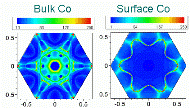Department of Physics and Astronomy: Publications and Other Research

Gordon Gallup Publications
Document Type
Article
Date of this Version
3-26-2007
Abstract
Cross sections for elastic and inelastic electron collisions with CH3X(X =Cl,Br, I) molecules are calculated. For the lowest partial wave, the resonance R-matrix theory, and for the higher partial waves, the theory of scattering by dipolar plus polarization potential, are used. It is shown that the rotationally elastic scattering amplitude for a polar molecule in the fixed-nuclei approximation is logarithmically divergent for the forward direction, and a closure formula is derived to speed up the convergence at small angles. In treating the nuclear motion, only C-X stretch vibrations are taken into account. The dipole moment as a function of the C-X distance is modeled by a function incorporating the experimental value of the molecular dipole moments at the equilibrium distance and the derivatives of the dipole moments extracted from the experimental data on infrared intensities. This is supplemented by ab initio calculations of the dipole moment function for CH3Br using the multiconfigurational valence bond method. The results for scattering cross sections show pronounced features caused by vibrational Feshbach resonances and threshold cusps. The features are most noticeable at the v=6, 7, and 8 thresholds in CH3Cl, at the v=3 and 4 thresholds in CH3Br, and at the v=1 threshold in CH3I.


Comments
Published by American Physical Society. Phys. Rev. A 75, 032719 (2007). http://pra.aps.org. Copyright © 2006 American Physical Society. Permission to use.